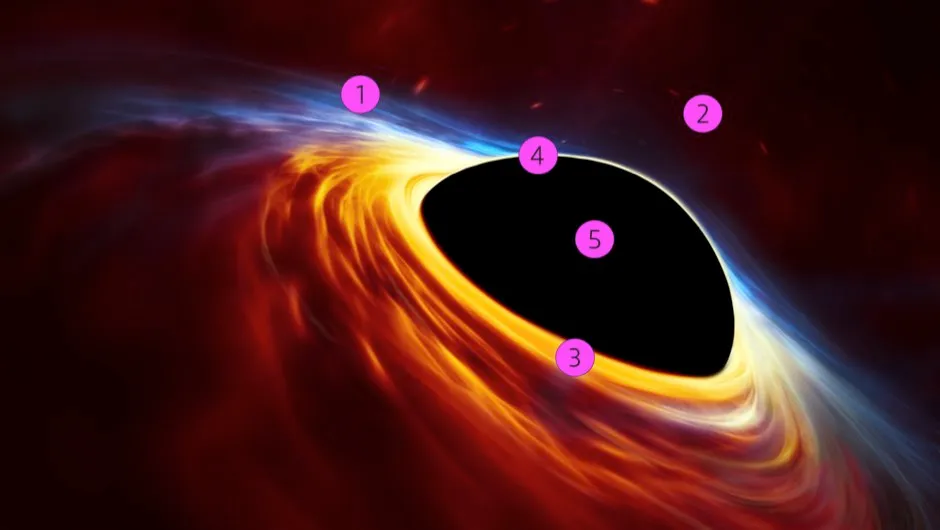The first ever image of a black hole has been released by the Event Horizon Telescope (EHT) Collaboration, an international organisation with scientists from 40 countries, in six simultaneous press conferences around the world. The EHT captured the supermassive black hole at the centre of the galaxy M87.
The black hole itself is completely dark as its gravitational pull is so immense that no light can escape it. What shows up in the image is the material surrounding the event horizon, commonly known as the ‘point of no return’, around the black hole.
Inside the event horizon, any matter or light is doomed to fall inwards. However, outside the event horizon, material swirls around the black hole at near light speed. Gravity and friction heat up the matter, which then glows with radio waves. It was these radio waves that were collected by the EHT.
Read more:
- Everything you wanted to know about black holes (and where to find them)
- Black holes: how did we discover these ‘dark stars’?
The EHT gathered the data in April 2017 over the course of a week-long observation, using eight telescopes in co-operation. At 55 million light-years from Earth, the supermassive black hole appears far too small in the sky for any one telescope to capture on its own. Although its enormous mass is 6.5 billion times that of the Sun, it is also incredibly dense, with a diameter about 30,000 times that of the Sun.
Just as an astronomical telescope can see further than a spyglass, the larger the telescope, the smaller (or further away) the object it can resolve, and the diameter of its mirror is the key. Astronomers frequently use a process called ‘interferometry’ to increase the resolution of their images, which uses several telescopes pointed at the same subject, to combine to make one telescope, with the distance between them being the diameter of the virtual telescope.
To pick out the tiny target at the centre of the M87, the EHT Collaboration produced a virtual telescope the size of the Earth by combining eight telescopes from around the globe. The resulting telescope can resolve objects that appear a million times smaller than the edge of a razor blade held at arm’s length.
Once the data from all eight telescopes was collected, the next task was to piece it together to form a complete picture. Astronomers around the world worked on analysing and processing the data and confirming the result before its release.
The behaviour of matter and light near the event horizon of a black hole is a fundamental test of Einstein’s theory of general relativity. An event horizon is one of the most extreme environments in the entire Universe, and any unexpected observations could point to previously undiscovered physics. The EHT Collaboration hope to explain some of the unsolved problems in physics, including whether the event horizon really is a point of no return.
- Watch How to See a Black Hole: The Universe's Greatest Mystery on BBC Four
Anatomy of a black hole

1
Accretion disc
The part of the black hole that gives away its location. Here, stars, gas and any other material nearby spiral towards the hole at blistering speeds, producing enormous amounts of electromagnetic radiation that we can detect here on Earth.
The objects sucked into the black hole become more frantic and crowded as they near the event horizon. Some are inevitably dragged beyond this point into the hole itself, while others are blasted outwards to create a jet.
2
Relativistic jets
Pop culture dictates that nothing escapes a black hole. But that's not quite true. Astronomers have observed jets of particles streaming out of black holes so long and fierce that they break out from their galaxy altogether. To borrow an analogy from Ass. Prof Konstantinos N Gourgouliatos, a theoretical physicist at the University of Durham, this is like a water fountain coming out of a 1cm-wide hosepipe and travelling 80 per cent of the way around the Earth (that's 10,000 kilometres).
Our best models suggest that black holes twist the fabric of spacetime at its poles. This effect coils magnetic fields, creating a cosmic corkscrew that accelerates particles close to the speed of light before firing them out into the void. At the same time, a magnetic dual-carriageway forms at the black hole's equator. This causes the magnetic field lines to twist and tangle, producing another particle accelerator effect.
Both of these effects create the fastest particles in the Universe, knocking at the door of the cosmic speed limit: the speed of light. In the long term, data from the EHT should help us understand this cosmic marvel in better detail.
3
Innermost stable orbit
The innermost edge of the accretion disc. This is the final region where material can safely orbit: any closer and it tumbles past the point of no return.
4
Event horizon
This is where the black part of the black hole begins. Beyond this point, material cannot escape the black hole's grip. More accurately, the escape velocity needed to free itself from the hole's gravitational pull is greater than the speed of light.
5
Singularity
All the matter and energy sucked into the black hole ends up here, at its centre: huge amounts of matter and energy are crushed into an infinitely small space, giving rise to the black hole's gravitational pull. Nobel Prize-winning theoretical physicist (and science consultant on the filmInterstellar) Kip Thorne described it as "a location where the laws of physics break down."
Follow Science Focus onTwitter,Facebook, Instagramand Flipboard